Cessna 162 Skycatcher: It‘s Here!
Cessna’s successor to the 152, the Skycatcher, is poised to shine in the trainer market
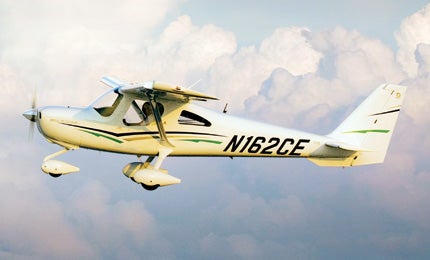 The proliferation of LSA since the FAA announced the first approval at Sun 'n Fun 2005 has been little short of amazing. LSA Editor at Large Jim Lawrence suggests that there now are more than 100 different LSA models.
The proliferation of LSA since the FAA announced the first approval at Sun 'n Fun 2005 has been little short of amazing. LSA Editor at Large Jim Lawrence suggests that there now are more than 100 different LSA models.
You can't help but recall the similar rush to create the GA market following World War II. In those days, practically everyone with a slide rule and a drawing board was designing little airplanes for the plethora of military pilots returning from Europe and the Pacific. It was a boom that turned bust in record time, leaving the dregs of several dozen aircraft companies in its wake.
With Cessna's heritage as the most popular manufacturer of GA trainers, the Wichita company was virtually guaranteed to enter this new market. The Model 162 Skycatcher was announced by Cessna President Jack Pelton in 2006, and by the time you read this, the first production airplane will have been delivered.
Cessna hopes the Skycatcher will help solve a major problem at Cessna since the demise of the 152. Like Piper and the old Beech Aircraft, Cessna always has fostered a basic trainer in hopes of strengthening the step-up market. The premise is that pilots who train in a particular brand are more likely to buy from the same manufacturer. Trouble is, the pilot population in general and student starts in particular have both declined dramatically in the last 30 years. In 1980, there were 820,000 licensed pilots. By 2007, that number had shrunk to well below 600,000. Though there was a slight improvement in the pilot population last year, Cessna knew it needed to facilitate the recovery by offering a new trainer of its own.
Despite the Skyhawk's remarkable simplicity and durability, it always has been too much airplane for the job, both in operating cost and purchase price. I recently reported on a new 2009 Skyhawk with a base price of $297,000. I know of a flight school in Long Beach, Calif., that rents a 2008 Skyhawk SP for $159 hourly. For flight schools struggling to survive in a tough economy, the hourly rate is the primary key to profit, and even if a new Skyhawk is a leaseback, the rental rate may be prohibitive for all but the most affluent students.
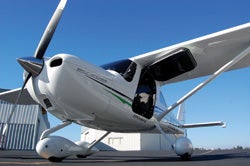 The Skycatcher was intended to confront that problem head-on. Accordingly, the base price has been set at $112,250, and Cessna calculates a typically equipped plane will go out the door at $130,364. At only 40% of the Skyhawk's cost and half the operating expense, it's hard to imagine a new Skycatcher renting for as much as a 172.
The Skycatcher was intended to confront that problem head-on. Accordingly, the base price has been set at $112,250, and Cessna calculates a typically equipped plane will go out the door at $130,364. At only 40% of the Skyhawk's cost and half the operating expense, it's hard to imagine a new Skycatcher renting for as much as a 172.
Cessna loaned the first production-conforming airplane to San Diego's King Schools, which is developing the Cessna Pilot Center private pilot training curriculum. From there, Cessna ferried the 162 to AOPA's Aviation Summit in Tampa, Fla., and that's where I flew the first machine with Cessna Chief Pilot Kirby Ortega.
The 162 was designed with economy of both price and empty weight in mind, the latter specifically to preserve a reasonable useful load. To that end, a standard production test airplane will come in with an empty weight of about 830 pounds. (The test airplane was still outfitted for flight-testing, so it was about 60 pounds heavier.) That should leave 490 pounds for people, fuel and stuff. With a full service of 24 gallons on board, the airplane retains 346 pounds of payload.
Starting at the spinner, the final-production Skycatcher uses an all-metal, fixed-pitch McCauley prop in place of the original composite blades. Similarly, the POC airplane's Rotax 912 has been replaced by a 100 hp Continental O-200D---a new, improved version of the Cessna 150's O-200A powerplant.
The new engine employs lighter components and a smaller battery (it looks like the battery on my BMW motorcycle) again in pursuit of the most difficult economy in aviation: reduced empty weight. In total, the new O-200 is 35 pounds lighter than the original used on the 150. As with the O-200A, the new engine burns 5.5 to 6 gph at max cruise, so 24 gallons allows about three hours' endurance plus reserve. TBO is 2,000 hours.
In pursuit of safety, Continental designed the oil dipstick with a clever 90-degree lock position. If the stick cap isn't locked into place by folding it horizontally, the oil-service door won't close, making it obvious from the cockpit that something's not right.
The nosegear is nonsteerable and full castering, and to my mind, that's a perfect combination for a trainer---lightweight, yet capable of providing better ground maneuvering than any airplane with a conventional steerable nosewheel. If you need to maneuver in a tight space, it's possible to turn the airplane 180 degrees in its own wingspan by simply holding one brake and adding power. In truth, locked-wheel turns aren't a good idea (they tend to flat-spot tires), but they're at least possible with a full-castering nosewheel---just don't try pushing the airplane straight backwards without a tow bar.
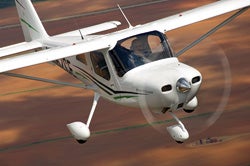 Perhaps in keeping with Cessna's tradition of building all-metal planes (okay, the Corvalis is primarily composite, but it didn't start off as a Cessna), the 162 is basically all aluminum, with only a few fiberglass components. The wheelpants, wingtips and wing/tail attach fairings are the only pieces that aren't aluminum.
Perhaps in keeping with Cessna's tradition of building all-metal planes (okay, the Corvalis is primarily composite, but it didn't start off as a Cessna), the 162 is basically all aluminum, with only a few fiberglass components. The wheelpants, wingtips and wing/tail attach fairings are the only pieces that aren't aluminum.
The wing is set well back on the 162 design, with struts mounted far enough aft that they don't interfere with the two cabin doors. Ailerons and flaps are interchangeable from one side to the other, and the ailerons offer max up travel and minimal down travel, an anti-spin improvement that was a fallout from the two spin accidents.
Both of those incidents have been well chronicled, so we won't belabor the subject here. The most relevant point is that full-power/full-flaps/full-cross-controlled stalls are well outside the province of LSA anyway. The FAA doesn't require such antics for LSA certification, but Cessna felt the tests were necessary to assure a safe airplane, especially one that would be used heavily for flight training.
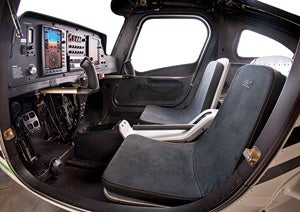 The 162's seats are fixed; however, both sets of rudder pedals are adjustable. |
The Skycatcher is the first Cessna to offer doors that open out and up, hinged at the top and spring-loaded to fold against the bottoms of the wings. The windows are fixed, and there are no small storm windows, so the airplane is approved to taxi with doors full up. As should be obvious, you can't open the doors in flight. Cessna employs standard airline Wemacs near the wing roots for internal airflow.
Like the rest of the airplane, the 162's cabin is a little different. The seats are fixed, though both sets of rudder pedals are adjustable fore and aft to accommodate long-legged aviators. The cabin is 44 inches wide at the shoulders, making the Skycatcher the second-widest piston airplane in Cessna's lineup (the Corvalis is the widest at 48 inches across). I'm only about five-foot-nine, but it was obvious headroom easily was adequate for a six-footer.
Cessna completely redesigned the 162's pitch-and-roll control to reduce weight and improve cabin access. The single handgrips resemble side sticks, but they work more like conventional joysticks. (Don't bother to twist your wrist as you would on a Cirrus or Corvalis; it won't accomplish anything.) The trick is that the sticks translate from the panel rather than the floorboards, closer to a yoke than a joystick. This unblocks panel space and frees up foot and legroom during entry/egress. The sticks offer conventional travel left and right, forward and aft, with no more friction than a stick or yoke control.
Pitch trim is electric, again a concession to weight. Failure mode is simply to overpower the trim, not a problem on such a light airplane. Flaps are manually deployed with a Johnson bar between the seats. There are four positions---0, 15, 25 and 40 degrees---and control pressures are moderate, with little buildup at the higher flap positions.
The panel is all Garmin, built around the new G300, a miniature, all-in-one, economy version of the popular G1000. In addition to most of the talents available on its big-brother, do-it-all glass panel, the Skycatcher's G300 offers one mode that's not available on the G1000: a weight-and-balance feature that offers a graphical representation of the CG envelope. The pilot merely inputs people, fuel and baggage pounds, and the system pops up a pictograph of the appropriate balance point. Pretty clever.
All electric switches are at top center panel: master, avionics and lights. The landing and position lights are Whelen multiple-element LEDs that should make the Skycatcher easy to spot. The 162 is approved for day/night/VFR flight only, though it can serve for IFR training in VFR conditions. The test airplane didn't have the autopilot or ballistic parachute options, but it was otherwise typically equipped. The BRS system costs $6,000 and weighs 35 pounds. It will be interesting to see how many people order the parachute.
Fuel gauges in each wing are the bubble variety, simple tubes that indicate quantity by head pressure. Interestingly, some engineer at Cessna wins the "duh" award for finally figuring out an inexpensive, silly-simple method of partial fueling. You can fuel each wing through one of three access tubes beneath the cap that corresponds to half full, three-quarters or topped. The tubes merely extend into the tanks to different levels.
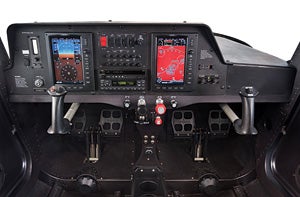 The Skycatcher's panel is built around the G300, a scaled-down version of the G1000. |
The space behind the seats is large, perhaps a little too large, as you may wind up with more cubes than pounds. Technically, the aft weight limit is 50 pounds. In keeping with the definition of LSA, Cessna won't offer an aft child's seat as an option since the airplane is only approved for two folks.
Back at the tail, there've been more changes as a result of the spin tests. The vertical stabilizer was reconfigured and enlarged slightly, and a ventral fin was added beneath the tail. The trim tab on the right elevator also received a gurney device: a small, wedge-shaped, metal tab attached to the trailing edge.
It's inevitable that the 162 will be compared to the old 150, and the new airplane comes off predictably better in practically all categories. With the same 100 hp engine, and 280 pounds less weight to lift, the new airplane shines in every performance parameter. Climb is an easy 200 fpm quicker at gross, and cruise is at least 10 knots faster than the 150's. Even payload is superior.
Roll response is faster than you might imagine. I tried a max stick deflection exercise from 60 degrees left to 60 degrees right, and the airplane responded far more quickly than a Skyhawk or Skylane. Pitch rate also is more sensitive than either of the next airplanes in Cessna's model line.
Dirty stall speed is about the same, but characteristics are more benign, if that's possible. I tried a variety of stalls, including a full-power departure stall with 50 degrees of bank, and the airplane did little more than bob its nose and roll back toward level.
Landings are similarly simple---flown as slowly as 50 knots with full flaps. The 162 retains reasonable flare with no tendency to drop out from under you, and landing roll can be as short as 650 feet.
One characteristic that takes a little adjustment is power-off descent. Cessna lists the 162's glide ratio as 10.1:1, considerably better than the 152's 7.4:1 lift/drag or the 9:1 recorded by most other piston singles. I had to use full-flap slips several times to get the aircraft down near the beginning of the runway.
As everyone must know by now, the 162 is being built, test-flown and certified in Shenyang, China, then disassembled, containerized and shipped to the United States for reassembly and sale. When I flew the Skycatcher in Florida, Cessna's order book stood at just above 1,000 airplanes, and first delivery was scheduled for early December.
Overall, the Skycatcher is an attractive package that's bound to give other LSA manufacturers more competition. At about $130,000 reasonably equipped, it should attract significant investment from flight schools. A comparable Flight Design CTLS, the most popular LSA, sells for about $9,000 more than the Skycatcher; Tecnam's Eaglet, the third most popular, is almost $13,000 more, with the same features; and the Remos GX, fourth best-selling, costs about $16,000 more. Pilots will be pleased with the new Skycatcher, and will be hard-pressed to find anything to dislike about it.

Subscribe to Our Newsletter
Get the latest Plane & Pilot Magazine stories delivered directly to your inbox





